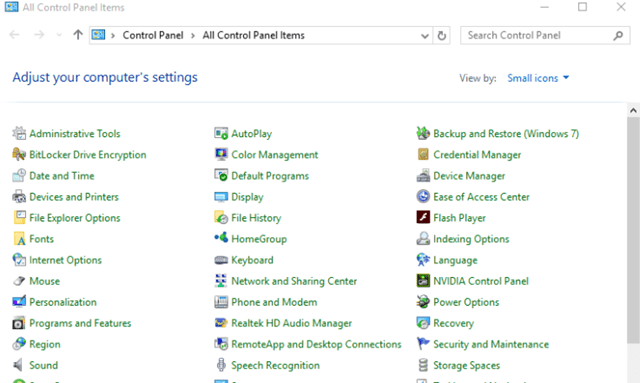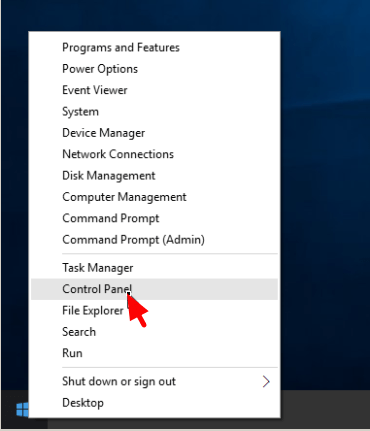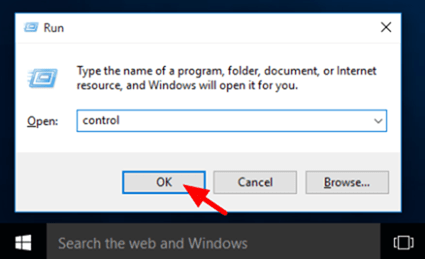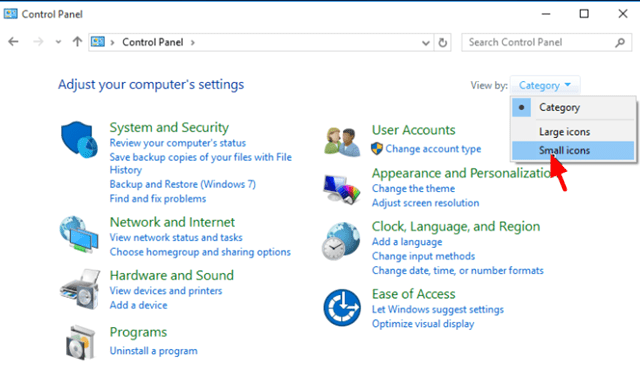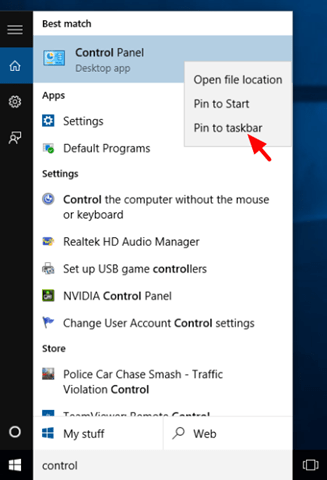- Включение и отключение компонентов Windows 10
- Работаем с Windows Features
- Управление Features on Demand (FOD)
- Установка и переустановка пакетов языков (Language Interface Packs, LIP)
- Turning on/off windows features in control panel
- How to find classic Control Panel in Windows 10
- Option 1. Using the new Start Button to open the Control Panel (Windows 10)
- Option 2. Using a command to access the Control Panel (Windows 10)
- Executing Control Panel Items
- Windows Vista Canonical Names
- New Commands for Windows Vista
- Personalization
- System
- Programs and Features
- Regional and Language Options
- Folder Options
- Power Options
- Legacy Control Panel Commands
Включение и отключение компонентов Windows 10
Как известно, Windows 10 отличается набором компонентов от предыдущих версий операционных систем Windows. Зачастую требуется их включить или выключить, чтобы они не потребляли системные ресурсы, да и просто не мешали. В этой статье мы рассмотрим как это сделать быстрее и эффективнее.
Начнем с того, что существует два основных способа работы с компонентами (они еще называются features) — утилита DISM и командлеты Powershell. И то и другое встроено в Windows 10, в отличие от Windows 7, где dism можно было добавить или установив пакет Windows ADK, или руками скопировав dism.exe с другого компьютера.
Сразу отмечу, что утилиту dism и среду powershell для работы с системой необходимо запускать от имени администратора, даже если ваш аккаунт уже находится в группе локальных админов. Итак, вы или находите cmd или windows powershell в меню и, кликнув правой кнопкой мышки, выбираете «Запуск от имени администратора».
В Windows 10 есть понятие Features и Capabilities. Первое — это привычные нам компоненты, которые можно найти в Панели управления -> Программы и компоненты -> Включение и отключение компонентов Windows. То есть это встраиваемые модули, которые выполняют определенный сервисный функционал.
Capabilities — это дополнительные возможности, которые расширяют возможности интерфейса и увеличивают удобство пользователя. Среди них — Language packs, наборы шрифтов. Да, Microsoft удалил часть нестандартных шрифтов, которые теперь вынесены в опциональные компоненты. Скачать эти компоненты можно в виде ISO файла с сайта Volume Licensing Service Center или напрямую через Internet и графический интерфейс Windows. Такую концепцию Microsoft назвала Features on Demand (FOD). Их в более ранних версия Windows не было.
Работаем с Windows Features
Итак, список установленных компонентов можно посмотреть командой
Dism /online /Get-Features
Вот как в Powershell можно получить список всех компонентов командлетами Get-WindowsFeature (для Windows Server) или Get-WindowsOptionalFeature (Windows 10):
Чтобы получить список отключенных компонентов, введите:
Get-WindowsOptionalFeature -Online | ? state -eq ‘disabled’ | select featurename
Этот список также можно вывести в файл (для windows Server):
Get-WindowsFeature | Where-Object <$_.Installed -match “True”>| Select-Object -Property Name | Out-File C:\Temp\WindowsFeatures.txt
Посмотрев список названий и их состояние, можно использовать эти названия для того, чтобы компоненты включить или выключить:
Dism /online /Enable-Feature /FeatureName:TFTP /All
ключ /All позволяет включить также все дочерние компоненты;
Установка компонентов через Powershell выполняется командой Enable-WindowsOptionalFeature.
Enable-WindowsOptionalFeature -Online -FeatureName RSATClient-Roles-AD-Powershell
Параметр -All включает все дочерние компоненты.
Dism /online /Disable-Feature /FeatureName:TFTP
Аналогично, через Powershell это можно сделать командой Disable-Windowsoptionalfeature -online -featureName [feature name].
Обратите внимание, некоторые фичи имеют разные названия в Windows 7 и Windows 10. Например, RSAT в Windows 7 — это RemoteServerAdministrationTools, а в Windows 10 — RSATclient.
Управление Features on Demand (FOD)
Если вы устанавливаете их через графический интерфейс, то вам необходимо пройти “System –> App & features –> Manage optional features” и нажать знак + напротив необходимых компонентов.
Чтобы сделать это автоматизированно через командную строку, наберите чтобы получить список доступных компонентов:
DISM.EXE /Online /Get-Capabilities
или на Powershell:
Как и прежде, запомните название необходимых вам компонентов, чтобы включить их командой (на примере .Net Framework 3):
DISM.EXE /Online /Add-Capability /CapabilityName:NetFx3
или на Powershell:
Add-WindowsCapability –Online -Name NetFx3
Если же у вас нет доступа в Интернет, то есть выход. Итак, вы скачиваете ISO образ диска с FOD компонентами с сайта Volume Licensing Service Center. Файлы будут разные для разных релизов Windows 10 — 1511, 1607, 1703, 1709. Важно помнить, что компоненты одного релиза не подходят к другому. Если вы сделаете in-place upgrade (установка одного релиза поверх другого через обновление), то несовместимые установленные компоненты будут удалены без вашего желания! Да, Microsoft удаляет то, что считает несовместимым при обновлении.
Так вот, ISO файл содержит набор неизвестных и сложных для понимания файлов с расширением cab. Вот чудесный файлик на сайта Microsoft, который обясняет назначение каждого файла. Итак, существуют следующие типы FOD:
- Microsoft-Windows-LanguageFeatures-Basic — проверка правописания для различных языков и раскладок клавиатуры;
- Microsoft-Windows-LanguageFeatures-Fonts — национальные шрифты, например, азиатские
- Microsoft-Windows-LanguageFeatures-OCR — средства для распознавания шрифтов
- Microsoft-Windows-LanguageFeatures-Handwriting — средства для распознавания рукописного ввода
- Microsoft-Windows-LanguageFeatures-TextToSpeech — средства преобразования текста в голос, используемые подсказчиком Cortana
- Microsoft-Windows-LanguageFeatures-Speech — распознавание голоса
- Microsoft-Windows-InternationalFeatures — пакеты национальных настроек, например, для Тайваня
Итак, для добавления таких FOD компонентов, используйте команды вида (замените имя компонента):
Dism /Online /Add-Capability /CapabilityName:Language.Basic
Для удаления FOD:
Dism /Online /Remove-Capability /CapabilityName:Language.Basic
Установка и переустановка пакетов языков (Language Interface Packs, LIP)
Язык интерфейса Windows можно поменять, установив так называемые LIP. ранее они назывались MUI (Multi user interface). Файлы LIP выглядят так: Microsoft-Windows-Client-Language-Pack_x64_es-es.cab для испанского языка. Выглядеть установка будет примерно так:
Dism /Add-Package /online /PackagePath:»C:\Languages\Microsoft-Windows-Client-Language-Pack_x64_fr-fr.cab»
Dism /Remove-Package /online /PackageName:Microsoft-Windows-Client-LanguagePack-Package
В следующей статье мы поговорим как с помощью DISM и Powershell управлять так называемыми Modern-приложениями AppX.
Turning on/off windows features in control panel
When a box is blue that means not all of the subfolders are checked. To view the subfolders, click the + next to a folder.
You can turn any of the listed features on or off — but you will not be able to use a feature while it’s turned off. Unless you need to turn a feature on or off, the settings can be left as they are.
To turn Windows features on or off, follow these steps:
To turn a Windows feature on, select the check box next to the feature. To turn a Windows feature off, clear the check box. Click OK .
Sharing bits of knowledge.
4 people found this reply helpful
Was this reply helpful?
Sorry this didn’t help.
Great! Thanks for your feedback.
How satisfied are you with this reply?
Thanks for your feedback, it helps us improve the site.
How satisfied are you with this reply?
Thanks for your feedback.
You can customize your Windows installation even more.
What can you remove?
- Internet Explorer 8
- Windows Media Player
- Windows Media Center
- Windows DVD Maker
- Windows Search
- Handwriting Recognition (through the Tablet PC Components option)
- Windows Gadget Platform
- Fax and Scan
- XPS Viewer and Services (including the Virtual Print Driver)
Microsoft does note there are consequences for removing certain features since third party programs and other Windows Features may have certain requirements or dependencies on functionality built into these critical components.
Application Dependencies are still a factor when removing features like Internet Explorer or Windows Search.
“It is worth describing the details of remove†since this too is a place where there are engineering and customer decisions to be made. We’ve already seen one decision which is to make sure we keep the features staged for future use so that a DVD is not required. A second decision is that we also continue to support the APIs available for features where these APIs are necessary to the functionality of Windows or where there are APIs that are used by developers that can be viewed as independent of the component. As many of you know these are often referred to as dependencies†and with Windows the dependencies can run both internal to Windows and external for ISVs.”
Windows Team member, Jack Mayo
How to find classic Control Panel in Windows 10
The new operating environment of Windows 10 has elements of classic Windows 7 OS, but also has elements from the most modern Microsoft’s operating system of Windows 8. So Windows 10 is more affordable – compared with Windows 8- to the traditional Windows users. At Windows 10 many basic menus are changed, but in some way they are hidden. The most common settings can be accessed from Settings App (Start button > Settings) but the amount of settings that can be found at the old style Control Panel.
In this tutorial you ‘ll find out the easiest ways to access the old style Control Panel in Windows 10.
Option 1. Using the new Start Button to open the Control Panel (Windows 10)
The easiest way (for me) to access the Windows 10 Control Panel is to right click with your mouse at the Start Button. By doing that, a new menu opens and there you will also find –except the «Control Panel» – the «Device Manager», the «Command Prompt» the «Network Connections» and some other basic settings to manage your computer.
Option 2. Using a command to access the Control Panel (Windows 10)
If you familiar with commands then:
- Press Windows + R keys to open the Run command box.
- Type control & click OK.
Tip 1: When you open Control Panel for first time go to View by: menu at the top left and set the view setting to Small Icons to display all control panel items.
Tip 2: To always have the Control Panel shortcut available.
- Go at «Search the Web and Windows» box and type: control
- At results: right-click at Control Panel (Desktop App) & select Pin to taskbar (or Pin to Start).
That’s all folks! Did it work for you?
Please leave a comment in the comment section below or even better: like and share this blog post in the social networks to help spread the word about this solution.
Executing Control Panel Items
If you are looking for the list of canonical and module names for Control Panel items, see Canonical Names of Control Panel Items.
There are two ways to open a Control Panel item:
- The user can open Control Panel and then open an item by clicking or double-clicking the item’s icon.
- The user or an application can start a Control Panel item by executing it directly from the command line prompt.
An application can open the Control Panel programmatically by using the WinExec function.
The following example shows how an application can start the Control Panel item named MyCpl.cpl by using the WinExec function.
When a Control Panel item is opened through a command line, you can instruct it to open to a particular tab in the item. Due to the addition and removal of certain tabs in some WindowsВ Vista Control Panel items, the numbering of the tabs might have changed from that in WindowsВ XP. For instance, the following example launches the fourth tab in the System item on WindowsВ XP and the third tab on WindowsВ Vista.
This topic discusses the following:
Windows Vista Canonical Names
In WindowsВ Vista and later, the preferred method of launching a Control Panel item from a command line is to use the Control Panel item’s canonical name. A canonical name is a non-localized string that the Control Panel item declares in the registry. The value of using a canonical name is that it abstracts the module name of the Control Panel item. An item can be implemented in a .dll and later be reimplemented as a .exe or change its module name. As long as the canonical name remains the same, then any program that opens it by using that canonical name does not need to be updated.
By convention, the canonical name is formed as «CorporationName.ControlPanelItemName».
The following example shows how an application can start the Control Panel item Windows Update with WinExec.
To start a Control Panel item with its canonical name, use: «%systemroot%\system32\control.exe /name canonicalName«
To open a specific sub-page in an item, or to open it with additional parameters, use: «%systemroot%\system32\control.exe /name canonicalName /page pageName«
An application can also implement the IOpenControlPanel::Open method to launch Control Panel items, including the ability to open a specific sub-page.
For a complete list of Control Panel item canonical names, see Canonical Names of Control Panel Items.
New Commands for Windows Vista
On WindowsВ Vista, some options that were accessed by a .cpl module on WindowsВ XP are now implemented as .exe files. This provides added security by allowing standard users to be prompted to provide administrator credentials when trying to launch the files. Options that do not require extra security are accessed by the same command lines that were used in WindowsВ XP. The following is a list of commands used in WindowsВ Vista to access specific tabs of Control Panel items:
Personalization
- Font size and DPI: %windir%\system32\DpiScaling.exe
- Screen resolution: %windir%\system32\control.exe desk.cpl,Settings,@Settings
- Display settings: %windir%\system32\control.exe desk.cpl,Settings,@Settings
- Themes: %windir%\system32\control.exe desk.cpl,Themes,@Themes
- Screensaver: %windir%\system32\control.exe desk.cpl,screensaver,@screensaver
- Multi-monitor: %windir%\system32\control.exe desk.cpl,Monitor,@Monitor
- Color Scheme: %windir%\system32\control.exe /name Microsoft.Personalization /page pageColorization
- Desktop background: %windir%\system32\control.exe /name Microsoft.Personalization /page pageWallpaper
Starter and Basic Editions do not support control.exe /name Microsoft.Personalization command.
System
- Performance: %windir%\system32\SystemPropertiesPerformance.exe
- Remote access: %windir%\system32\SystemPropertiesRemote.exe
- Computer name: %windir%\system32\SystemPropertiesComputerName.exe
- System protection: %windir%\system32\SystemPropertiesProtection.exe
- Advanced system properties: %windir%\system32\SystemPropertiesAdvanced.exe
Programs and Features
- Add or remove programs: %windir%\system32\control.exe /name Microsoft.ProgramsAndFeatures
- Windows features: %windir%\system32\OptionalFeatures.exe
Regional and Language Options
- Keyboard: %systemroot%\system32\control.exe /name Microsoft.RegionalAndLanguageOptions /page /p:»keyboard»
- Location: %systemroot%\system32\control.exe /name Microsoft.RegionalAndLanguageOptions /page /p:»location»
- Administrative: %systemroot%\system32\control.exe /name Microsoft.RegionalAndLanguageOptions /page /p:»administrative»
Folder Options
- Folder searching: %windir%\system32\rundll32.exe shell32.dll,Options_RunDLL 2
- File associations: %windir%\system32\control.exe /name Microsoft.DefaultPrograms /page pageFileAssoc
- View: %windir%\system32\rundll32.exe shell32.dll,Options_RunDLL 7
- General: %windir%\system32\rundll32.exe shell32.dll,Options_RunDLL 0
Power Options
- Edit current plan settings: %windir%\system32\control.exe /name Microsoft.PowerOptions /page pagePlanSettings
- System settings: %windir%\system32\control.exe /name Microsoft.PowerOptions /page pageGlobalSettings
- Create a power plan: %windir%\system32\control.exe /name Microsoft.PowerOptions /page pageCreateNewPlan
- There is no canonical command for the Advanced Settings page, it is accessed in the older manner: %windir%\system32\control.exe powercfg.cpl,,3
Legacy Control Panel Commands
When you use the WinExec function, the system can recognize special Control Panel commands. These commands predate WindowsВ Vista.
| control.exe desktop | Launches the Display Properties window.
|
